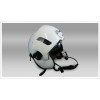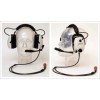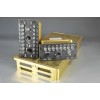The helmet is designed to be used both onboard the aircrafts (by Pilot, Co-Pilot and crew members) and during ground applications (while assisting ground engine running operations and/or engine startup/rotor engagement).
The helmet is designed to improve the quality of the communication (i.e. in terms of intelligibility) and the understanding of the personnel working in high-noise environment conditions, which typically characterize the environment of interest (in proximity or onboard aircrafts with engines running).
1. HELMET DEscriptION
1.1. GENERAL CHARACTERISTICS
• The helmet is characterized by a modular design that will allow for customization with respect to sizing, visor system, communication system, oxygen mask compatibility and helmet mounted devices. Thanks to its high customization capability, the helmet is also extremely comfortable and ergonomic, and it is easily adaptable for suitability to different rotary wing aircraft platforms.
• The proposed helmet is compatible with different types of low-level impedance (8-16 Ω) helicopters/aircrafts, and it shall be characterized by a dynamic microphone (output level equal to 150 µV).
• The helmet is NVG goggles compatible
• The helmet is colored with the required NATO standard white color.
1.2. Technical DEscriptION
1.2.1. External hood
• The helmet shell is made by a light weight Kevlar/Carbon fiber composite.
• This design solution assures an high durability of the external hood, in order to sustain the impact conditions required by the qualification process.
1.2.2. INTERNAL HOOD
• The internal hood is equipped with nape pad, edge roll system and a foam pad fitting system, which comprises comfort liners in different thickness that allow an easy personalization fit of the helmet to various users head size and shape.
• The adjustable nape support provides enhanced stability, especially when using the various helmet mounted devices.
• All the adopted materials is shock absorbent, and shall assure an optimal adhesion with the helmet.
1.2.3. VISORS
• The helmet is equipped with acrylic visors, and it shall be also provided with polycarbonate visors.
• The helmet is delivered with a double visor system with independent movement and locking of either of the visors (the two visors can operate independently or both together).
• The double visor system is composed by clear and neutral grey tinted visors (standard visors provided).
• The visors is attached to their mounting brackets with screws that can be removed when a visor is changed.
• In addition, the helmet is provided with a semi rigid visor cover for visor protection.
Note: the rigid cover also acts as the base for mounting the helmet mounted devices.
1.2.4. WEIGHT
The helmet weight, with face protection and NVG mounting fitted, is 1405 g.
1.2.5. SIZES AND BALANCE
1.2.5.1. SIZES
• The helmet is available in three sizes (Small, Medium and Large).
1.2.5.2. BALANCE
• The helmet weight is equally distributed over the head without showing any localized pressure.
• The adjustable nape support provides enhanced stability, especially when using various helmet mounted devices.
1.2.6. MICROPHONE SYSTEM
1.2.6.1. dynamic
The helmet is equipped with flex-boom (dynamic) microphone, in order to provide superior acoustic, environmental, altitude-capable and noise-canceling performances.
The dynamic microphone has the following characteristics:
• Input Sensitivity: equivalent to M-87/M-101;
• Input Impedance: 5 Ω nominal.
1.2.6.2. ELECTRET (optional)
The helmet can also be delivered with the following characteristics:
• Input Sensitivity: Dynamic Range: 20mV to 1.5 V, M170;
• Input Impedance: 150 Ω nominal.
1.2.7. PASSIVE NOISE REDUCTION SYSTEM
Passive attenuation of the helmet. Attenuation values are expressed in dB. The noise is a typical helicopter noise at 120 dB SPL.
FREQUENCY PASSIVE ATTENUATION [dB]
250 Hz 29
500 Hz 21
1000 Hz 19
2000 Hz 32
4000 Hz 45
8000 Hz 55
1.2.8. Shell Color
The helmet shell is colored with different colors (white color included), all characterized by a low absorbability and NVG compatible.
2. SYSTEM PERFORMANCES
2.1. AUDIO SYSTEM PERFORMANCES
2.1.1. Frequency Response
The frequency response of the helmet speakers shall not vary more than ± 6 dB in the frequency range of 350 Hz to 3000 Hz.
2.1.2. Distortion
The distortion of the helmet speaker shall not exceed 10 % over the frequency range of 350 Hz to 3000 Hz considering an output level of 110 dB (20 µPa),
2.1.3. Acoustic quality
Through all the allowed frequency range (350 Hz to 6000 Hz) the acoustic quality shall be optimal: there shall be no buzzing, rattles or other spurious noises which would impair the quality of the reproduced signal.













